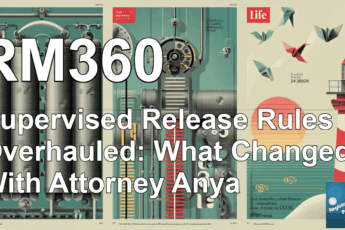In the realm of American criminal justice, few topics spur as much contention and curiosity as plea bargaining. Often described as a “necessary evil,” this widespread practice forms the backbone of how most criminal cases are resolved in the United States—yet, it’s routinely misunderstood by the general public and sharply debated by legal professionals, reformers, and everyday citizens caught in its web. Is plea bargaining truly a “bargain” for those accused? Does it uphold or undermine the ideals of justice? And why do the outcomes in similar cases diverge so drastically, varying not only between individuals but across states and jurisdictions?
In this comprehensive article, we dive deep into the nitty-gritty of plea bargaining. Leveraging insights from a detailed conversation between Andy and Larry (hosts of the Registry Matters Podcast), we’ll unpack the realities, misconceptions, and moral conundrums of this pivotal institution. You’ll learn what plea bargaining really is, why it dominates our justice system, how it contributes to massive sentencing disparities, and where both the pitfalls and opportunities for reform lie.
What Is Plea Bargaining, and Is It Really a “Bargain”?
At its core, a plea bargain is an agreement in a criminal case between the prosecution and the defendant. In exchange for pleading guilty to a lesser charge, or only some of the charges, the accused receives a lighter sentence or reduced charges than if they risked a full trial—potentially facing far more severe penalties.
According to Larry, a legal practitioner, plea bargaining—when done as intended—can look like a lifeline for defendants facing overwhelming odds. “People are often facing decades or even life in prison,” he points out. “The plea process reduces their exposure, if it’s done correctly, and provides some level of certainty to the outcome.” The critical caveat is “if it’s done correctly”—an ideal not always met in the real world.
The Stakes: What’s on the Table?
To understand the stakes, consider this: Defendants are regularly charged with multiple counts for a single incident, each carrying hefty potential sentences. Prosecutors often “stack” charges, sometimes threatening cumulative sentences in the hundreds of years. As Larry explains, “If you have 45 counts, each carrying a maximum of ten years and can be stacked consecutively, that’s 450 years in prison. If I can cut that risk down to ten years, it is definitely a bargain.”
The logic is starkly pragmatic: reduce risk, gain predictability, and avoid life-derailing uncertainty. But critics argue this dynamic is ripe for abuse.
The Mechanics of Power: Charging Practices and Leverage
Prosecutorial Power in Charge Stacking
It’s no secret that prosecutors possess significant power to influence plea negotiations. By stacking charges, they can present defendants with a devastating “trial penalty”—the difference between the sentence offered in a plea and the sentence they’d face if convicted at trial. As Andy points out, this can feel coercive, leaving defendants little real choice.
Larry concedes that prosecutors often “embellish” charges, ramping up their negotiating leverage, though he draws the line at outright invention. “If they do [invent charges] and you can prove it, that’s a breach of ethics subject to sanctions,” he says. Still, the reality remains: The system incentivizes guilty pleas, even for individuals who may have credible defenses or have been overcharged.
The Role of Sentencing Guidelines, Community Norms, and Political Climate
In addition to charging strategies, a patchwork of sentencing laws and practices dramatically shapes plea outcomes. Sentencing practices vary not only between states but within them. Larry gives the example of a statutory charge for criminal sexual penetration of a minor under thirteen. A seventeen-year-old who is two days short of adulthood can be charged and sentenced identically to a forty-five-year-old who assaults a much younger child. The statute doesn’t distinguish, despite the radically different facts.
Furthermore, community values color every aspect of the process. A defendant in a rural, conservative district may face far harsher penalties than one in a metropolitan area, even for identical crimes. As Larry observes, “People are different from state to state, and even within the same state.”
Why Do Non-Contact Offenders Sometimes Receive Harsher Penalties Than Violent Offenders?
One of the most controversial disparities in sentencing arises with non-contact offenses, such as child pornography possession. In many instances, non-contact offenders can receive lengthier sentences than those handed to violent or contact offenders. Why?
Larry’s explanation is blunt: “It’s what the people want. The citizenry is frightened by non-contact offenders, and we have made tough laws for those who commit such heinous offenses.” Lengthy, consecutive sentences result when each image or piece of evidence is charged separately. Sometimes, as Andy notes, authorities count individual frames from a single video as separate “images,” rapidly multiplying the counts and potential years of incarceration—leading, in one notorious Texas case, to a 300-year sentence compared to a far shorter term for a homicide.
Societal Fears and Legislative Responses
Public perception, shaped by media coverage and advocacy groups, plays an enormous role. Larry points out that, especially since the advent of the Internet, laws have grown stricter, fueled by a sense of urgency to protect society’s most vulnerable. Scarcity of legislative nuance means statutes often don’t account for level of harm or intent, resulting in harsh, sometimes unjust, outcomes.
State vs. Federal Court: Two Systems, Two Worlds
Federal Courts
Federal courts are widely regarded as more severe in both charging and sentencing. Congress, Larry notes, has all but eliminated parole and sharply restricted “good time” credits, with most federal prisoners serving at least 85% of their sentence. Federal sentencing is determined by a complex grid system that calculates “offense levels” and “criminal history,” piling on “enhancements” (aggravating factors) and rarely offering “reductions.” As a result, federal defendants have less negotiating room in plea bargains—the judge often cannot accept a deal that binds them to a particular sentence.
State Courts
In contrast, state courts have somewhat more flexibility. It’s not uncommon for state plea deals to be more tailored, sometimes specifying exact sentences or ranges, especially in busy, overburdened jurisdictions. However, latitude varies enormously from state to state, sometimes even county to county.
Is There a Folk Solution? Why the System Doesn’t Change
A frequently suggested “fix” is for all defendants to reject plea bargains and demand trials, gumming up the system so thoroughly that reform becomes inevitable. While logically appealing, Larry dismisses this as impossible. “Defense attorneys have an ethical obligation to seek the outcome that’s in the best interest of the client,” not to use cases as sacrificial pawns in the service of systemic change. Further, the American justice system—unlike some collectivist societies—revolves around individual, not collective, interests.
The Power of Political and Public Will
Ultimately, sentencing laws and justice policy reflect the priorities of lawmakers and, by extension, their constituents. According to Larry, most people do pay attention to criminal justice issues, especially around election time, and politicians have long competed to appear “tough on crime.” Efforts at sentencing reform, such as the bipartisan push in Congress in 2016, often wither in the face of political rhetoric and public fear-mongering.
Defending the System—With Reservations
Despite its flaws, Larry professes a degree of faith in the system. The core processes—proof beyond reasonable doubt, the presumption of innocence, neutrality of judges and juries—remain sound on paper, even though they’re endangered by external pressures. He’s acutely aware, however, that a powerful “victim advocacy industrial complex” wields enormous influence through media, legislation, and fundraising, making reform especially challenging.
When asked how to “claw back” justice from this imbalance, Larry concedes the difficulty: “Victims’ advocates have a lot of organizations. They outmatch our advocacy maybe 20 to one, a hundred to one in terms of fundraising… [and] easy access to the media in a favorable setting. I don’t know how we take away the hijacking because they’re extremely influential through the legislative process.”
Key Insights and Takeaways
- Plea bargaining is the backbone of the American criminal justice system—resolving more than 90% of cases—but often operates in a gray area between justice, efficiency, and coercion.
- Prosecutors wield enormous leverage through strategic charge stacking and the looming threat of severe sentences, compelling most defendants to take plea deals, sometimes regardless of actual culpability or fairness.
- Sentencing disparities are systemic, influenced by legislative design, community sentiment, political climate, and technical quirks (like how offenses are charged per “image”), leading to wildly different outcomes for similar conduct.
- Reform is politically difficult. Public fear and victim advocacy groups exert strong influence, making sentencing policy “tough on crime” and resistant to nuanced change.
- While the ideals of justice remain intact on paper, their application is threatened by external pressures and a culture that often presumes guilt and favors punishment over rehabilitation or fairness.
Actionable Takeaways
- For Concerned Citizens: Stay informed about legislative changes and support organizations advocating for fair, evidence-based sentencing reform.
- For Legal Professionals: Advocate vigorously for clients within the existing framework, but also participate in broader advocacy to educate the public on the realities and ethics of plea bargaining.
- For Policymakers: Engage with diverse stakeholders—including victims, defendants, experts, and the public—to craft nuanced laws that reflect both public safety and proportional justice.
Conclusion
Plea bargaining remains an indispensable component of the U.S. criminal justice system, a product of pragmatism, expediency, and the realities of courtroom pressures and limited resources. Yet, its routine practice raises profound moral questions about fairness, equality, and the true nature of justice. As sentencing disparities persist and public trust in the system wavers, the need for thoughtful conversation and structural reform grows ever more urgent. The challenge lies not in dismantling the entire system but in recalibrating its priorities—balancing efficiency with equity, accountability with compassion, and safety with justice.
If you found this analysis helpful, consider listening to the Registry Matters Podcast for more in-depth discussions on criminal justice reform and related topics.
Further Reading:
– “Why Plea Bargains Are Even More Unjust Than People Think,” The Atlantic, 2017
– “Sentencing Disparities and the ‘Trial Penalty’,” National Association of Criminal Defense Lawyers, 2021
– “The Sentencing Project: The State of Sentencing 2023”





Leave a Comment